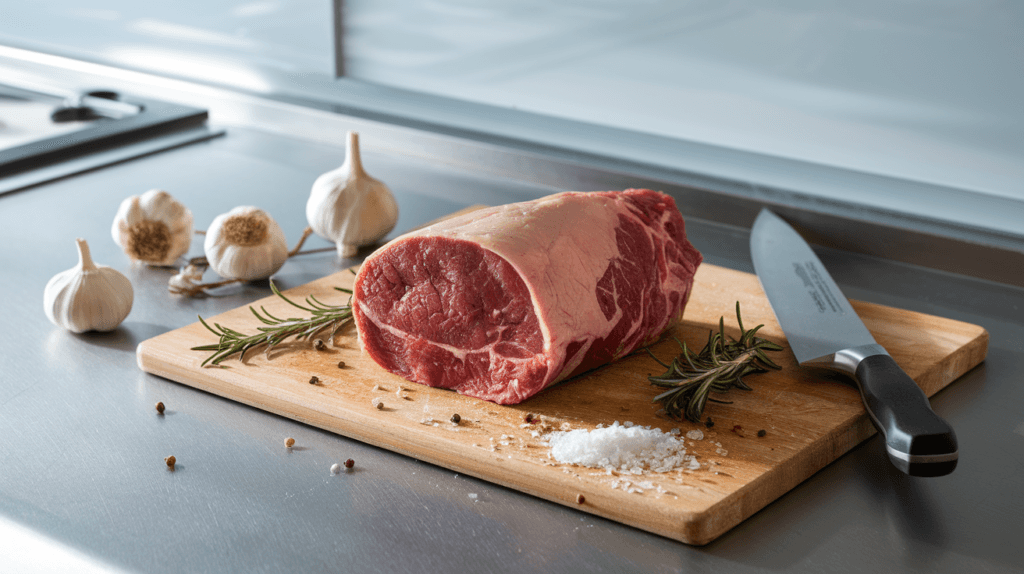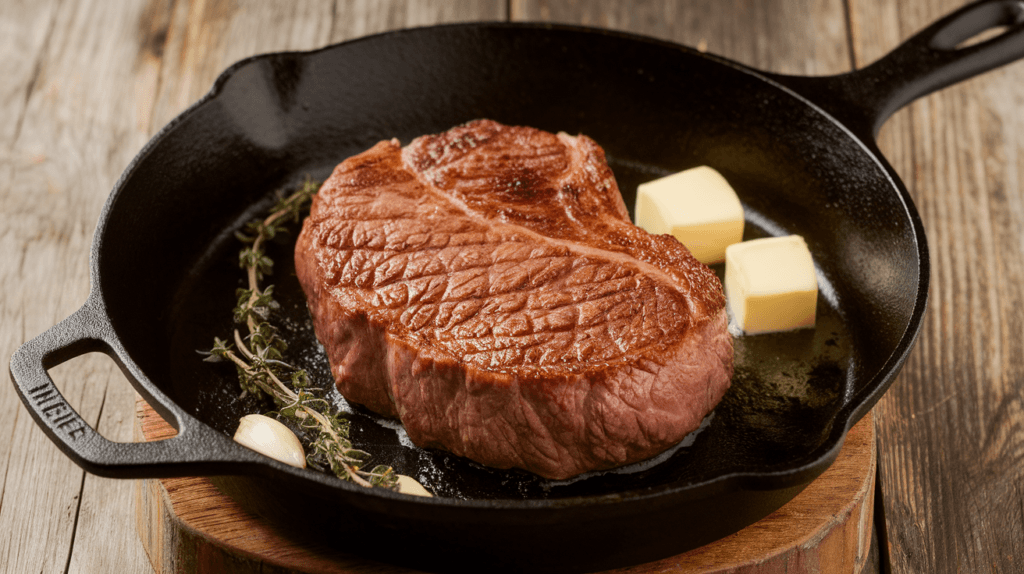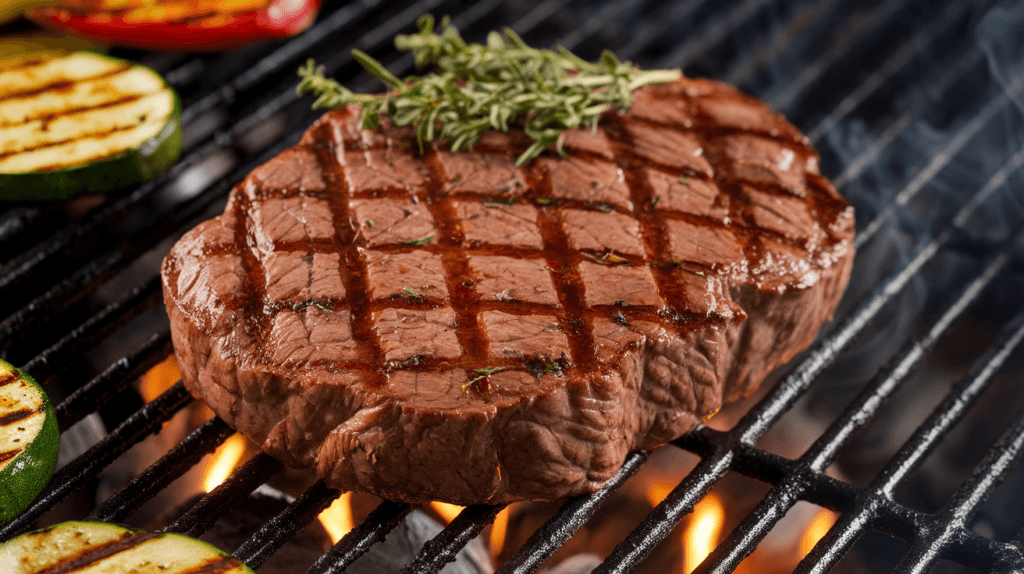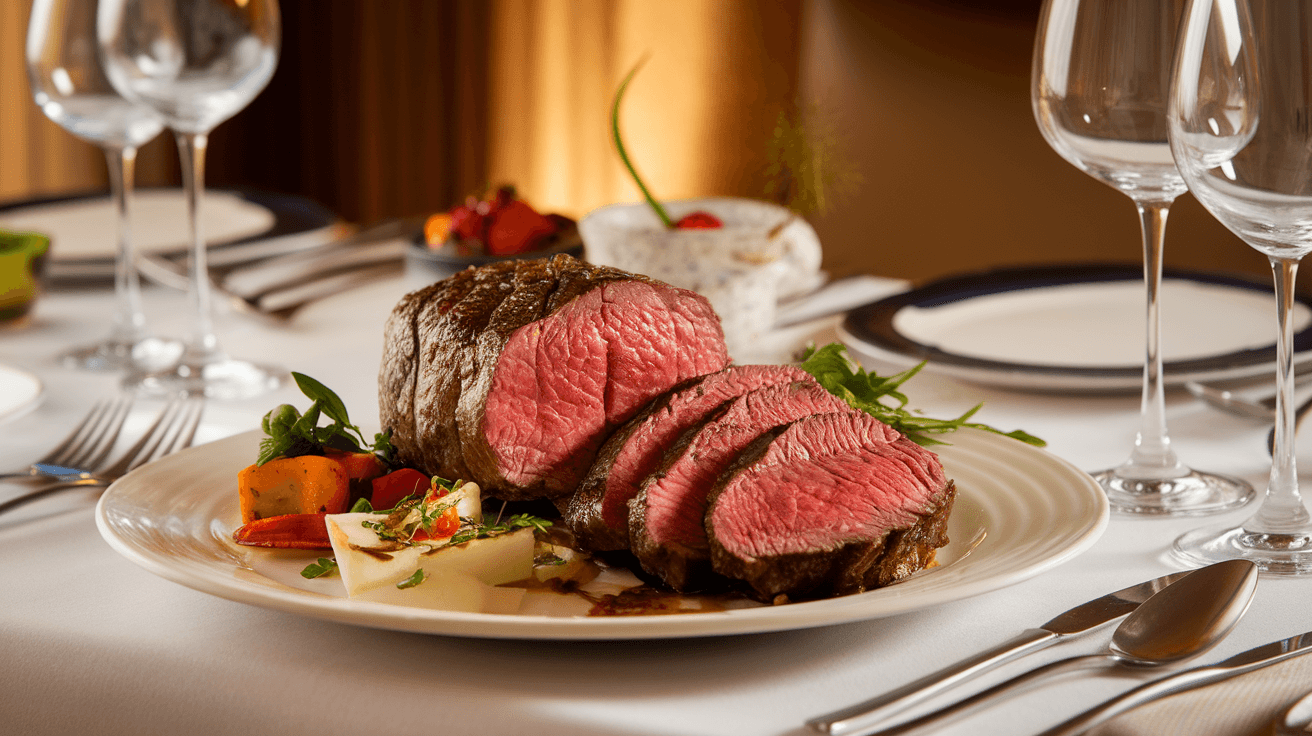Introduction
Beef tenderloin, often referred to as the most luxurious cut of beef, is revered for its incredible tenderness and subtle flavor. It’s the star of celebratory meals and fine dining, often making appearances at festive gatherings and special occasions. However, achieving the perfect beef tenderloin requires more than just high-quality meat—it demands a precise cooking method.
This raises the question: Which cooking method is best for beef tenderloin? Selecting the right cooking method not only enhances the natural flavors of the beef tenderloin but also ensures it remains juicy, tender, and perfectly cooked. From the sizzle of a cast-iron skillet to the controlled precision of sous vide, every method offers unique benefits. In this article, we’ll explore which cooking method is best for beef tenderloin, compare their pros and cons, and provide step-by-step guides to mastering each approach.
Understanding Beef Tenderloin

What Is Beef Tenderloin?
Beef tenderloin is a long, cylindrical cut of meat that comes from the cow’s loin section. This muscle does very little work during the cow’s lifetime, making it incredibly tender compared to other cuts. It’s the source of filet mignon steaks and is considered a prized cut in culinary circles.
Characteristics of Beef Tenderloin
- Tender Texture: The hallmark of beef tenderloin is its unparalleled tenderness.
- Mild Flavor: Unlike fattier cuts, tenderloin has a more subtle beefy taste.
- Versatility: Its shape and size allow it to be prepared as a whole roast, individual steaks, or medallions.
Understanding these traits helps explain why specific cooking methods complement this cut better than others. Tenderloin’s delicate texture and lean composition make it less forgiving of overcooking, requiring careful preparation.
Factors That Influence Cooking Beef Tenderloin
Cooking beef tenderloin to perfection is not just about selecting the right method—it’s also about understanding the factors that can influence the cooking process. These factors ensure that the final dish aligns with your expectations for flavor, texture, and doneness.
1. Cut Size and Thickness
The size and thickness of the beef tenderloin play a significant role in determining the cooking time and technique:
- Whole Tenderloin vs. Steaks: Whole tenderloins take longer to cook and are often roasted or grilled. Individual steaks, like filet mignon, are better suited for pan-searing or grilling.
- Thickness Matters: Thicker cuts retain moisture better and are ideal for slow methods like roasting or sous vide, while thinner cuts benefit from quick, high-heat techniques.
2. Desired Doneness
Your preferred level of doneness is crucial in deciding the cooking method. Beef tenderloin is at its best when cooked medium-rare, with a warm pink center and a tender, juicy texture. Here’s a general guideline for internal temperatures:
| Doneness Level | Internal Temperature |
|---|---|
| Rare | 120–125°F (49–52°C) |
| Medium-Rare | 130–135°F (54–57°C) |
| Medium | 140–145°F (60–63°C) |
| Well-Done | 160°F+ (71°C+) |
Using a meat thermometer ensures accuracy, no matter the cooking method.
3. Tools and Equipment
The tools you use can elevate your beef tenderloin cooking experience. Essential items include:
- Cast-Iron Skillet: Ideal for pan-searing, as it retains and evenly distributes heat.
- Oven Thermometer: Helps monitor oven temperature for precise roasting.
- Sous Vide Machine: Perfect for precision cooking, maintaining consistent temperatures.
- Grill: Adds a smoky, charred flavor to the tenderloin.
- Meat Thermometer: Ensures the tenderloin reaches the desired doneness.
Top Cooking Methods for Beef Tenderloin
Let’s dive into the most popular cooking methods for beef tenderloin, each offering distinct benefits and flavor profiles.
1. Pan-Seared Beef Tenderloin

Pan-searing is a quick and effective way to cook beef tenderloin, especially when paired with oven roasting for thicker cuts.
- Best For: Filet mignon or tenderloin steaks.
- Process: Sear the beef in a hot cast-iron skillet with butter and aromatics like garlic and thyme. Finish in the oven for even cooking.
2. Oven-Roasted Beef Tenderloin
Oven roasting is a classic method for cooking whole beef tenderloin, allowing for even heat distribution and a juicy interior.
- Best For: Whole tenderloin roasts.
- Process: Season the tenderloin generously, sear it in a skillet for a crust, and roast in a preheated oven at 425°F (220°C) until the desired doneness is reached.
3. Grilled Beef Tenderloin

Grilling imparts a smoky, charred flavor that complements the tenderloin’s mild beefiness.
- Best For: Both whole tenderloin and steaks.
- Process: Preheat the grill to medium-high heat, season the tenderloin, and cook over direct heat for a crust, then finish over indirect heat.
4. Sous Vide Cooking for Tenderloin
Sous vide is a foolproof method for achieving perfect doneness every time.
- Best For: Any cut of tenderloin, especially if precision is a priority.
- Process: Vacuum-seal the tenderloin with seasonings, cook it in a water bath at a controlled temperature, and finish with a quick sear for a golden crust.
Comparative Analysis of Cooking Methods
Choosing the best cooking method for beef tenderloin requires an understanding of how each approach affects the meat’s texture, flavor, and overall quality. Let’s compare the four main methods: pan-searing, oven-roasting, grilling, and sous vide.
Pan-Searing Beef Tenderloin
Pros:
- Quick and convenient, ideal for smaller portions like steaks.
- Produces a flavorful, caramelized crust.
- Can be paired with oven-roasting for thicker cuts.
Cons:
- Risk of uneven cooking if not finished in the oven.
- Requires constant attention to avoid overcooking.
Flavor Profile and Texture:
- Delivers a rich, buttery flavor enhanced by aromatics.
- Creates a crispy exterior while keeping the interior tender.
Oven-Roasting Beef Tenderloin
Pros:
- Excellent for larger cuts, such as whole roasts.
- Ensures even cooking throughout the meat.
- Easy to add complementary flavors, like herbs or a crust.
Cons:
- Takes longer to cook than other methods.
- Requires a pre-sear for a flavorful crust.
Flavor Profile and Texture:
- Mild, evenly cooked meat with a tender, juicy interior.
- The searing step adds depth and a slight crunch to the exterior.
Grilling Beef Tenderloin
Pros:
- Imparts a smoky, charred flavor unique to grilling.
- Suitable for both steaks and whole tenderloin.
- Creates a visually appealing grill-marked surface.
Cons:
- Can be tricky to control the heat and avoid overcooking.
- Risk of drying out the meat if not monitored carefully.
Flavor Profile and Texture:
- A bold, smoky taste with a crisp, charred exterior.
- Juicy interior if cooked to the right doneness.
Sous Vide Cooking for Tenderloin
Pros:
- Precision cooking ensures perfect doneness every time.
- Preserves the meat’s natural juices and tenderness.
- Can hold the meat at the ideal temperature for hours before serving.
Cons:
- Requires specialized equipment (sous vide machine, vacuum sealer).
- Lacks a natural crust unless seared post-cooking.
Flavor Profile and Texture:
- Intensely tender and moist, with minimal flavor loss.
- Post-searing enhances the crust and visual appeal.
How to Choose the Best Method
The choice of cooking method often depends on factors such as the occasion, available equipment, and personal preferences. Here’s a quick guide to help you decide:
- For Maximum Flavor and Crust: Opt for pan-searing or grilling.
- For Precision and Convenience: Choose sous vide cooking.
- For Serving Larger Groups: Oven-roasting is the way to go.
- For Smoky, Charred Notes: Grilling adds a unique outdoor flavor.
Step-by-Step Guide: Pan-Seared and Roasted Beef Tenderloin
Pan-searing followed by oven roasting is a hybrid method that offers the best of both worlds—a flavorful crust and a tender interior. Here’s how to do it:
1. Preparing the Beef
- Take the tenderloin out of the refrigerator at least 30 minutes before cooking to allow it to come to room temperature.
- Pat it dry with paper towels and season generously with kosher salt and freshly ground black pepper.
- Optionally, rub the beef with olive oil and minced garlic for added flavor.
2. Searing the Tenderloin
- Heat a heavy cast-iron skillet over high heat until it’s smoking hot.
- Add a small amount of neutral oil (like canola or vegetable oil) and swirl to coat the pan.
- Place the tenderloin in the skillet and sear each side for 2–3 minutes, until a deep golden-brown crust forms.
3. Roasting the Tenderloin
- Preheat the oven to 425°F (220°C).
- Transfer the seared tenderloin to a roasting pan or keep it in the skillet if it’s oven-safe.
- Roast in the oven until the internal temperature reaches your desired doneness:
- 130°F (54°C) for medium-rare.
- 140°F (60°C) for medium.
- Use a meat thermometer to monitor the temperature accurately.
4. Resting the Meat
- Once out of the oven, let the tenderloin rest for 10–15 minutes before slicing. This allows the juices to redistribute, ensuring every bite is tender and flavorful.
Step-by-Step Guide: Grilling Beef Tenderloin
Grilling beef tenderloin is an excellent choice for those who crave smoky, charred flavors. Whether you’re preparing a whole tenderloin or individual steaks, this method ensures a flavorful crust and a juicy interior.
1. Preparing the Grill
- Preheat the Grill: Set up your grill for two-zone cooking—direct and indirect heat. Preheat to medium-high heat (375–450°F or 190–230°C). If using charcoal, light the coals and pile them on one side of the grill.
- Clean and Oil the Grates: Use a grill brush to clean the grates, then oil them lightly with a paper towel dipped in vegetable oil to prevent sticking.
2. Preparing the Tenderloin
- Trim the Beef: Remove any excess fat or silver skin from the tenderloin using a sharp knife.
- Season Generously: Rub the tenderloin with olive oil, and season with salt, pepper, and your choice of spices (rosemary, thyme, or smoked paprika work well).
- Optional Marinade: For added flavor, marinate the beef in a mixture of olive oil, minced garlic, balsamic vinegar, and soy sauce for 1–2 hours before grilling.
3. Cooking the Beef Tenderloin
- Sear Over Direct Heat: Place the tenderloin over the direct heat zone and sear each side for 2–3 minutes. This step creates the signature grill marks and locks in the juices.
- Finish Over Indirect Heat: Move the tenderloin to the indirect heat zone. Close the grill lid and cook until the internal temperature reaches your desired doneness:
- Medium-rare: 130°F (54°C)
- Medium: 140°F (60°C)
- Rotate and Monitor: Turn the tenderloin occasionally to ensure even cooking. Use a meat thermometer to check the internal temperature.
4. Resting and Serving
- Once done, transfer the tenderloin to a cutting board and tent it with foil. Let it rest for 10–15 minutes to allow the juices to redistribute.
- Slice the beef into medallions or steaks and serve with your favorite sides, such as roasted vegetables, mashed potatoes, or a fresh salad.
Step-by-Step Guide: Sous Vide Beef Tenderloin
Sous vide cooking is the ultimate method for achieving consistent, restaurant-quality results. It locks in moisture and tenderness, making it nearly impossible to overcook the beef.
1. Setting Up Sous Vide Equipment
- Fill the Water Bath: Use a large pot or sous vide container filled with water. Attach the sous vide machine and set it to your desired cooking temperature:
- Medium-rare: 130°F (54°C)
- Medium: 140°F (60°C)
2. Preparing the Beef
- Season the Tenderloin: Rub the beef with olive oil, salt, pepper, and herbs (e.g., rosemary or thyme). You can also add garlic or a pat of butter for extra flavor.
- Vacuum Seal the Meat: Place the tenderloin in a vacuum-seal bag or a resealable freezer bag using the water displacement method to remove air.
3. Cooking the Tenderloin Sous Vide
- Submerge the Bag: Lower the sealed bag into the water bath, ensuring it’s fully submerged. Clip it to the side of the container if necessary.
- Cook Time: Allow the beef to cook for 1–3 hours. Longer cooking times will not overcook the beef but will enhance tenderness.
4. Finishing the Tenderloin
- Sear for a Crust: Once the sous vide cooking is complete, remove the beef from the bag and pat it dry with paper towels. Heat a skillet with a small amount of oil or butter until it’s very hot.
- Sear Each Side: Quickly sear the tenderloin for 1–2 minutes on each side to develop a golden-brown crust.
5. Rest and Serve
- Let the beef rest for a few minutes after searing, then slice and serve. Pair it with a rich sauce like red wine reduction or béarnaise for added elegance.
Mistakes to Avoid When Cooking Tenderloin
While beef tenderloin is forgiving in terms of texture, a few common mistakes can detract from its flavor and quality. Here’s what to avoid:
- Overcooking the Meat:
- Tenderloin is lean and can quickly dry out if overcooked. Always use a meat thermometer to monitor the temperature.
- Skipping the Resting Step:
- Resting allows the juices to redistribute, ensuring every bite is moist and flavorful.
- Underseasoning:
- Beef tenderloin’s mild flavor benefits from generous seasoning with salt, pepper, and complementary herbs.
- Neglecting the Sear:
- A proper sear creates a flavorful crust that elevates the dish.
- Cooking Cold Meat:
- Bringing the tenderloin to room temperature before cooking ensures even heat distribution.
FAQs About Cooking Beef Tenderloin
Here are six frequently asked questions about cooking beef tenderloin, with detailed answers to help you achieve the best results.
1. How Do I Keep Beef Tenderloin Juicy?
To keep beef tenderloin juicy, follow these tips:
- Avoid Overcooking: Use a meat thermometer to monitor the internal temperature, and remove the tenderloin from heat as soon as it reaches the desired doneness.
- Rest the Meat: After cooking, allow the tenderloin to rest for 10–15 minutes under foil to let the juices redistribute throughout the meat.
- Choose the Right Cooking Method: Sous vide or roasting at moderate temperatures helps lock in moisture better than high-heat methods like grilling.
2. Should I Marinate Beef Tenderloin?
While beef tenderloin doesn’t require a marinade due to its natural tenderness, marinating can enhance its flavor. Consider marinades that are light and complementary, such as mixtures of olive oil, garlic, fresh herbs (like rosemary or thyme), and a splash of acidic ingredients like lemon juice or balsamic vinegar.
3. Can I Cook Tenderloin Well-Done and Still Keep It Tender?
Yes, but it’s challenging. Tenderloin is lean, so cooking it well-done can make it dry. To counteract this:
- Use sous vide cooking to maintain tenderness while achieving a higher doneness.
- Baste frequently with butter or broth during roasting to add moisture.
- Serve the well-done beef with a sauce, like a red wine reduction, to counter dryness.
4. How Long Should I Cook Beef Tenderloin?
Cooking times depend on the cut size, thickness, and method. As a general guide:
- Pan-seared Steaks: Cook each side for 3–4 minutes, then finish in the oven if needed.
- Oven-Roasted Whole Tenderloin: Roast at 425°F (220°C) for 20–30 minutes for medium-rare.
- Grilled Tenderloin: Grill over direct heat for 2–3 minutes per side, then move to indirect heat to finish.
- Sous Vide: Cook at 130°F (54°C) for medium-rare, for 1–3 hours.
Conclusion
Beef tenderloin is a prized cut of meat that, when cooked properly, can elevate any meal into a fine-dining experience. Each cooking method—whether it’s pan-searing, grilling, oven-roasting, or sous vide—offers unique benefits, and your choice should align with your equipment, preferences, and the occasion.
For a quick and flavorful option, pan-searing delivers a rich crust and tender interior. Oven-roasting is ideal for larger groups, while grilling provides a bold, smoky flavor. For ultimate precision and juiciness, sous vide stands out as the modern, foolproof approach.
With proper preparation, the right tools, and careful attention to doneness, you’ll consistently achieve tender, juicy beef tenderloin that impresses every time. Now it’s your turn to select your method, fire up your kitchen, and enjoy the rewards of perfectly cooked tenderloin!

